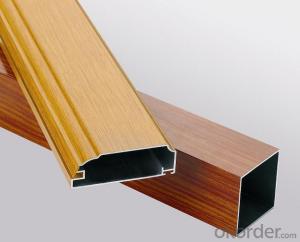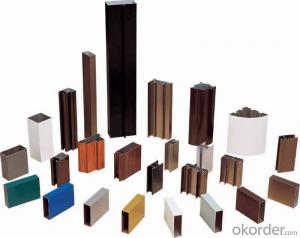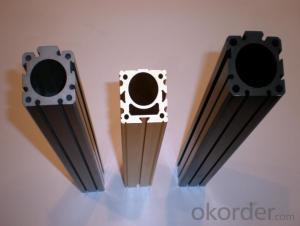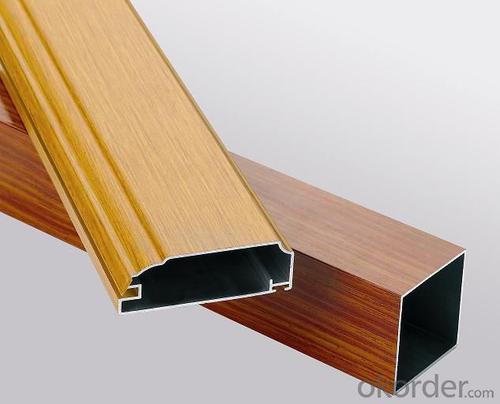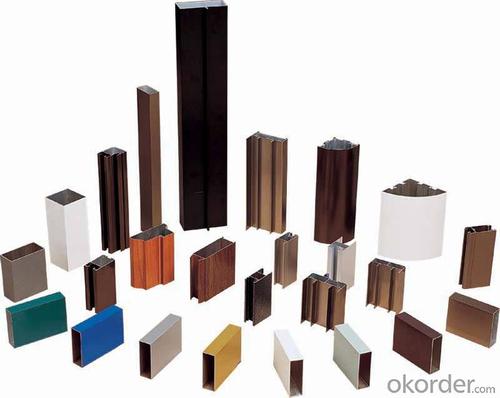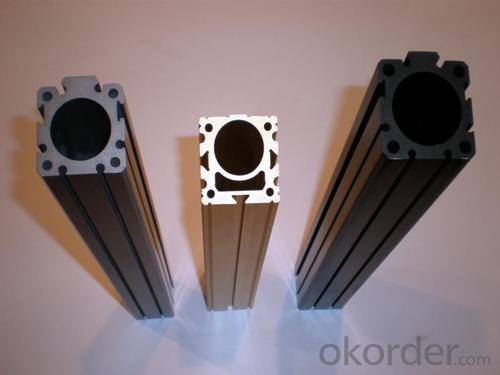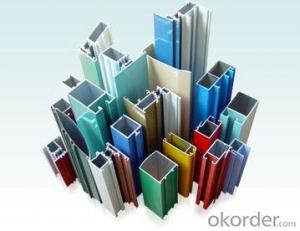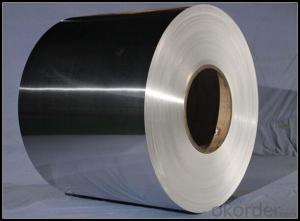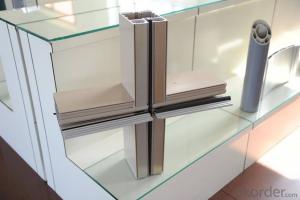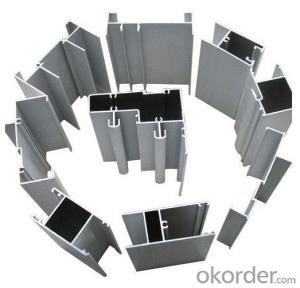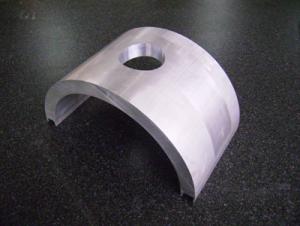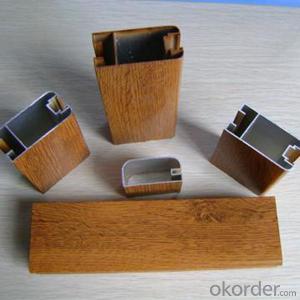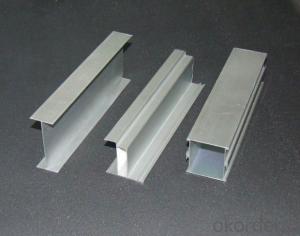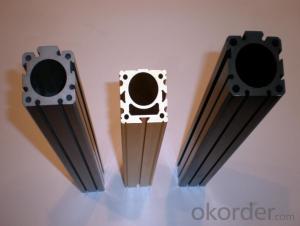Custom China Extruded Aluminum Profiles - Best Selling Colorful Anodizing Aluminium Profiles
- Loading Port:
- China Main Port
- Payment Terms:
- TT OR LC
- Min Order Qty:
- -
- Supply Capability:
- -
OKorder Service Pledge
OKorder Financial Service
You Might Also Like
Aluminium profile
1) Alloy: AA6061, AA6063
2) Temper: T5, T6
3) Series of surface treament:
1. Mill Finished
2. Anodizing: Silver, champagne, light bronze, dark bronze, black, light titanium, dark titanium.
3. Electrophoretic Coating: Silver, champagne, bronze, black, light bronze, dark bronze.
4. Electrostatic Color Powder Coating: Normal color, special color.
5. Fluorocarbon Powder Spraying: Normal color, special color.
6. Wood Grain Coating: Import paper, domestic paper.

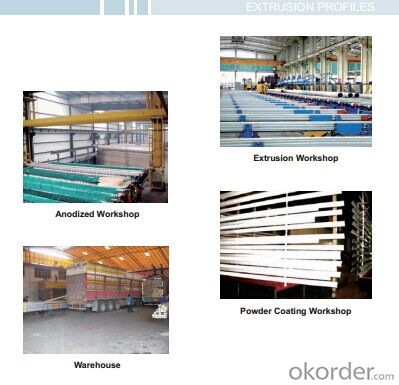
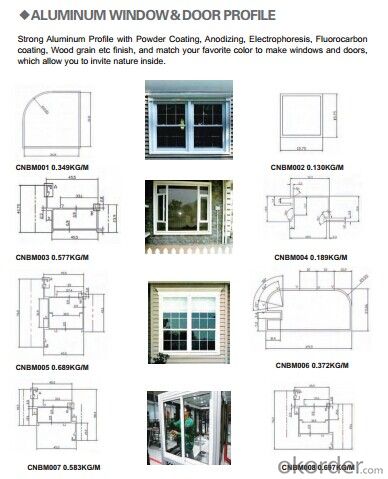
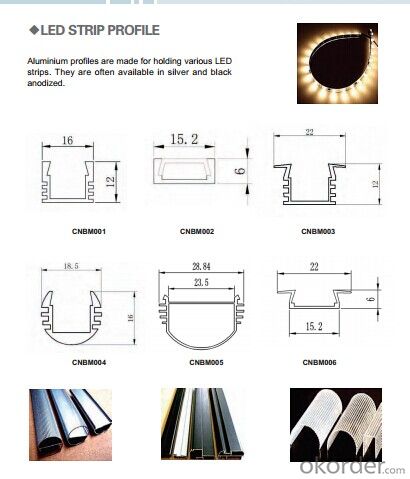

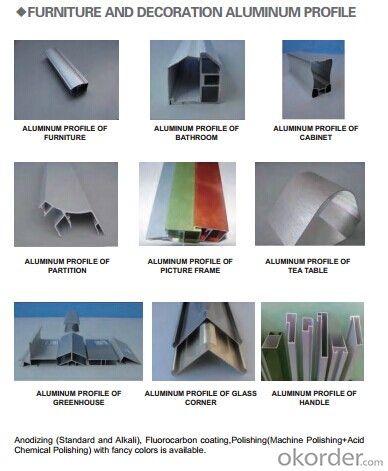
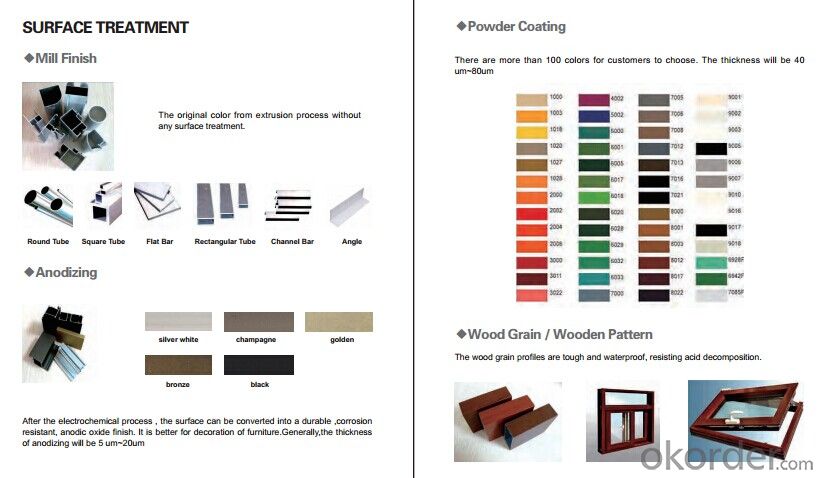
- Q: This question asks for methods to prevent moisture from entering aluminum profiles during the installation process.
- <p>To prevent moisture from getting into aluminum profiles during installation, ensure proper sealing and insulation. Use high-quality weatherstripping and sealants around joints and connections. Install moisture barriers or vapor retarders where necessary, especially in areas prone to high humidity. Keep profiles dry during handling and storage, and avoid installing in wet conditions. Regularly inspect and maintain the profiles to identify and address any potential moisture issues early.</p>
- Q: This question asks about the impact of aluminum profiles on a building's ability to withstand fire.
- <p>Aluminum profiles can affect the fire resistance of a building in several ways. While aluminum itself has a high melting point and doesn't burn, it does conduct heat, which can lead to rapid temperature increases in the structure. To mitigate this, aluminum profiles used in construction are often coated with fire-resistant materials or combined with non-combustible materials. Additionally, the design of the building and the use of fire barriers can help to slow the spread of fire and heat. It's crucial to follow building codes and standards that specify the appropriate use of aluminum in fire-resistant construction to ensure the safety and integrity of the structure during a fire.</p>
- Q: I want to make my aluminum oxide, how much money is needed is a set of equipment? Please leave, thank you!
- The price of the equipment is not primary, mainly because of the technical requirements of oxidation. "This is not as simple as you think."
- Q: How can the aluminum profile T6 and T5 be distinguished?
- Hardness is generally measured by a Brinell hardness tester. T5 is subjected to high temperature molding and air cooling quenching in the shortest possible time. The T6 is treated with solid solution after artificial aging. So there is a difference between the two. But from the appearance of it is difficult to judge, experienced hands can be used to swing aluminum, roughly judged
- Q: Can aluminum profiles be used for skylights?
- Skylights can indeed utilize aluminum profiles. The durability, strength, and corrosion resistance of aluminum make it a popular choice for skylight frames. Its lightweight yet robust nature ensures the skylight glass is adequately supported and guarantees long-lasting performance. Furthermore, aluminum profiles can be effortlessly tailored and molded to meet specific design needs, enabling a wide range of skylight styles and sizes. Incorporating aluminum profiles in skylights also offers exceptional thermal insulation, promoting energy efficiency by minimizing heat transfer and condensation. In summary, aluminum profiles are a dependable and pragmatic choice for skylight construction.
- Q: Aluminum 3100-6063-T5, please
- Aluminum in the industry according to material characteristics, such as hardness, strength, corrosion resistance and other categories, there are 8 main series, each series with 4 figures as a brand, and subdivided into many types1 series industrial pure aluminum: 1XXX2 series superhard aluminum material: 2XXX3 series easy cutting aluminum material: 3XXX4 series easy cutting aluminum material: 4XXX5 series magnesium aluminum alloy: 5XXX6 series anodic oxidation and corrosion resistant aluminum: 6XXX7 Series aviation ultra hard aluminum: 7XXX8 series: 8XXXYou say 3100-6063-T5 may contain the 3 and 6 series, easy to cut and resistant to corrosion,.T5 indicates hardness levels
- Q: Can aluminum profiles be used in warehouse and storage systems?
- Warehouse and storage systems can utilize aluminum profiles. These profiles possess qualities such as being lightweight, durable, and resistant to corrosion, which make them suitable for a variety of applications in warehouses and storage systems. They can be utilized for the construction of shelving units, racks, and partitions in order to optimize storage space and arrange inventory. Aluminum profiles are also highly versatile, allowing for easy customization and assembly to fulfill specific storage requirements. Furthermore, these profiles offer an exceptional strength-to-weight ratio, enabling them to support heavy loads without compromising the structural integrity. Overall, due to their durability, flexibility, and cost-effectiveness, aluminum profiles are widely preferred in warehouse and storage systems.
- Q: Which price is expensive for aluminum profiles 6063-T6 and 6063-T5?
- Alloy number: China's current general is the United States Aluminum Association "Aluminium Association" number. We giveExamples are as follows: 1070-H14 (pure aluminum)2017-T4 (heat treatment alloy)3004-H32 (non heat treated alloy)
- Q: This question asks about the impact of aluminum profiles on the thermal efficiency of a building.
- <p>Aluminum profiles can significantly affect the thermal performance of a building. They are excellent conductors of heat, which means they can transfer heat quickly. This property can be both advantageous and disadvantageous. On the positive side, aluminum profiles can help dissipate heat from the building, reducing the need for air conditioning. However, they can also lead to heat loss in colder climates, reducing the building's energy efficiency. To mitigate this, thermal breaks are often incorporated into aluminum profiles to reduce heat transfer. Additionally, insulating materials can be used alongside aluminum profiles to enhance the building's thermal insulation. Proper design and material selection are crucial to optimize the thermal performance of a building with aluminum profiles.</p>
- Q: Are aluminum profiles suitable for use in exterior wall systems?
- <p>Yes, aluminum profiles are commonly used for exterior wall systems due to their durability, low maintenance, and resistance to corrosion and weathering. They offer a lightweight and strong alternative to traditional materials, and can be designed to provide thermal insulation and aesthetic appeal. Their versatility allows for various configurations and customizations, making them suitable for a wide range of architectural styles and requirements.</p>
Send your message to us
Custom China Extruded Aluminum Profiles - Best Selling Colorful Anodizing Aluminium Profiles
- Loading Port:
- China Main Port
- Payment Terms:
- TT OR LC
- Min Order Qty:
- -
- Supply Capability:
- -
OKorder Service Pledge
OKorder Financial Service
Similar products
Hot products
Hot Searches
Related keywords
